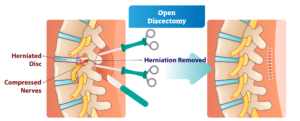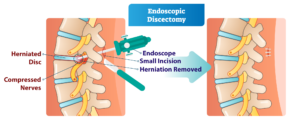When is Spinal Surgery Necessary?
When it comes to spinal surgery it’s usually to treat herniated discs, spinal stenosis, or back pain and possibly paralyzing spinal damage. Back pain is one of the most common ailments to people, and when lower back pain can’t be managed by anti-inflammatory medications, heat therapy or physical therapy, back surgery is the next step in managing the issue.
If a degenerative disc is causing arm or leg numbness then surgery is likely going to be necessary. When a herniated disc isn’t going away on its own, you may need a surgery to resolve your pain. There are many different types of spinal surgery that treat various causes of back and neck pain.
Do You Need Back Surgery?
Lower back pain can become paralyzing, and may affect the use of your arm or legs with numb pain through both. The compressed nerves in your spine are what causes the symptoms of leg or arm numbness. The nerves become compressed due to bulging discs, bone spurs, or spinal stenosis. Through an open MRI (Magnetic Resonance Imaging) machine doctors can analyze the root cause of your back pain and come up with an appropriate treatment plan.
After reviewing your MRI scan, your neurologist will evaluate if the herniated disc, spinal stenosis, or bone spur needs to be operated on. The initial step for a herniated disc may be pain management to see if the herniation will resolve on its own. If the neurosurgeon determines surgery is the necessary next step for you to consider, there are a few options to explore.
Spinal Stenosis Surgery
When it comes to spinal stenosis surgery it’s used to treat the narrowing of the foramen in the spine. The bone narrows with aging degeneration and compressed the nerve of your spine, causing you pain and possibly difficulty using your arms or legs.
It’s possible to manage your symptoms of stenosis by changing how you do certain activities, physical therapy, exercise, or taking pain medications. If you’ve tried these and you still have debilitating pain preventing you from your daily life then surgery is something to consider.
Back surgery has risks such as infection, nerve damage, and chance it won’t fully relieve your symptoms. However, spinal stenosis surgery can relieve your pain and make it easier to move around. It’s up to you to decide if the benefits of surgery are worth the risks.

Decompressive Laminectomy
The most common surgery to treat spinal stenosis is a decompressive laminectomy. Your bone, or thickened tissue, or both are removed to relieve the pressure on your spinal nerves and stops them from narrowing the spinal canal in the future.
Spinal Fusion Surgery
Spinal fusion is an operation that fuses two vertebrae together and keeps the spine stable. This is used to treat herniated discs, instability due to spinal arthritis, and scoliosis of the spine. Some risks are associated with spinal fusion, such as infection, blood clots, injury to nerves, and pain where the bone graft is taken.
You’ll be put under general anesthesia and an incision will be made at the vertebrae area that’s being operated on. A bone graft can be taken from a bone bank, or from your own body, usually from your pelvis, and is applied to the two vertebrae being fused. Metal rods and screws are used to keep the bone in place as the graft heals over and the fusion is completed. It can take several months for the fusion to fully heal and a brace may be recommended to keep your spine properly aligned.
Herniated Disc Surgery
Herniated disc surgery is generally going to involve a discectomy, possibly combined with a laminectomy. There is also a percutaneous laser disc decompression surgery which is non-invasive since it involves a thin needle insertion through the back. Percutaneous laser disc decompression (or PLDD) places the needle directly into the bulging disc, using the heat from a laser to decompress the disc and relieve pressure on your nerve. This avoids cutting of any kind, and leaves your bones in tact.
The alternative, a typical discectomy, may include open surgery where a neurosurgeon will cut away pieces of your spinal disc, and a laminectomy which removes a piece of bone called the lamina, to make space to access the disc.
Open discectomy is a large cut, and the surgeon operates like normal to remove portions of the herniated disc. Endoscopic discectomy involves the use of an endoscope, which is a thin tube with a camera at the end of it. The hollow tube allows surgical tools to be fed through and operate on the patient, with the camera giving the surgeon sight of where they are operating. Because of the endoscope the incision site is much smaller and is a less invasive surgery than open discectomy.
Minimally Invasive Spine Surgery
Endoscopic surgery is considered a minimally invasive spinal surgery technique. The thin tube grants access to the areas requiring surgical procedures without disrupting more areas of the body to get to them.
Percutaneous Laser Disc Decompression is also a minimally invasive technique since it only requires a needle, even smaller than an endoscope, to reach the disc bothering a patient. Because of this it’s generally a very quick surgery and doesn’t have many complications.
Recovery Time for Spinal Surgery
For more major surgeries such as spinal fusion the recovery time can be months, and you’ll have to be careful to keep your spine aligned during recovery. Many times a brace is necessary to keep the spine aligned, and physical therapy needed to teach the patient how to keep the alignment correct while moving and doing various activities.
For a decompressive laminectomy the recovery time can be a few days to a few weeks depending on the level of activity. You can probably resume a light level of activity after this time, but avoid straining your back or disturbing the incision location too much.
Laser decompression surgery recovery time is even shorter, since there is no incision and no bone is removed for this process. You can get back to your usual activity levels almost immediately, you just have to be monitored for a short time after the surgery to ensure everything looks good and your pain is alleviated.


